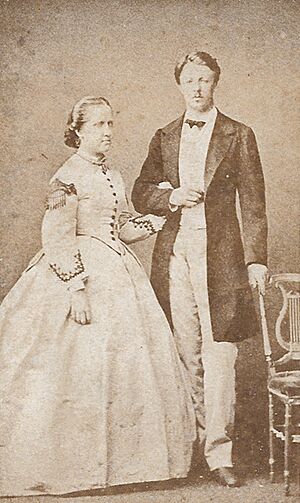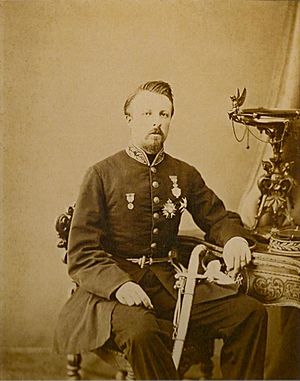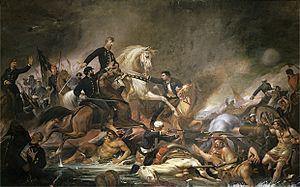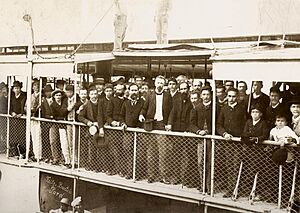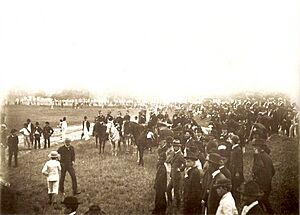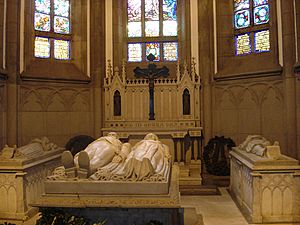Gaston, Count of Eu facts for kids
Quick facts for kids Prince Gaston of Orléans |
|||||
|---|---|---|---|---|---|
| Count of Eu | |||||
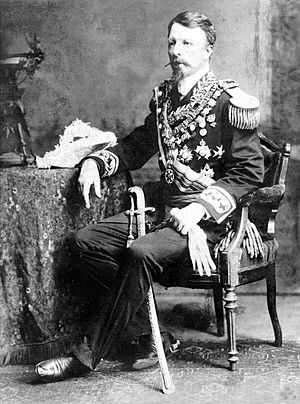
Photograph by Alberto Henschel, c. 1882
|
|||||
| Born | 28 April 1842 Neuilly-sur-Seine, France |
||||
| Died | 28 August 1922 (aged 80) Rio de Janeiro, Brazil |
||||
| Burial | Cathedral of São Pedro de Alcântara, Petrópolis, Brazil | ||||
| Spouse | |||||
| Issue |
|
||||
|
|||||
| House | Orléans | ||||
| Father | Prince Louis, Duke of Nemours | ||||
| Mother | Princess Victoria of Saxe-Coburg and Gotha | ||||
| Religion | Roman Catholic | ||||
| Signature | |||||
 Coat of Arms of Gaston, Count of Eu |
|||||
Prince Gaston of Orleans, Count of Eu (born Louis Philippe Marie Ferdinand Gaston; April 28, 1842 – August 28, 1922) was a French prince and a skilled military leader. He fought in the Spanish-Moroccan War and the Paraguayan War. He was the first son of Louis, Duke of Nemours, and Princess Victoria of Saxe-Coburg and Gotha. Gaston married Princess Isabel, who was the daughter of Pedro II of Brazil and the future heir to the Brazilian throne.
Contents
Early Life and Education

Gaston was born on April 28, 1842, in Neuilly-sur-Seine, near Paris, France. His full name was Louis Philippe Marie Ferdinand Gaston of Orléans. His parents were Louis, Duke of Nemours, and Princess Victoria of Saxe-Coburg and Gotha. His grandparents included King Louis Philippe I of France.
Gaston was part of the House of Orléans, a branch of the House of Bourbon, which was a famous French royal family. From birth, he was given the title of Count of Eu.
He received an excellent education. He learned several languages, including Latin, English, German, and Portuguese.
When Gaston was only five years old, his grandfather, King Louis Philippe, gave up his throne during the French Revolution of 1848. Gaston and his family then moved to England, living in exile at a mansion called Claremont.
In 1855, at age 13, Gaston began his military training. He studied artillery in Spain and quickly became a captain. He had moved to Spain to live with his uncle, Antoine, Duke of Montpensier.
Marriage to Princess Isabel
Spain had problems with Morocco due to pirate attacks. So, Spain declared war on Morocco. Young Gaston, still a military officer, joined the Spanish forces. He fought in all the battles and gained a reputation for his bravery.
Later, his uncle, King Ferdinand II of Portugal, suggested that Gaston marry one of the daughters of Emperor Pedro II of Brazil. Gaston agreed, but only after meeting the princesses first. The Emperor's sister, Princess Francisca, wrote a letter describing Gaston. She said he was "robust, tall, handsome, good-natured, very friendly, very educated, studious, and he also has a small military fame."
Gaston arrived in Rio de Janeiro on September 2, 1864. He came with his cousin, Prince Ludwig August of Saxe-Coburg and Gotha. They went to the Palace of São Cristóvão to meet the Brazilian imperial family. Gaston was not very impressed with the princesses at first.
Initially, Gaston was supposed to marry Princess Leopoldina, and his cousin would marry Princess Isabel. However, after they spent more time together, Emperor Pedro II decided to switch the pairs. Gaston became fond of Isabel. They were married on October 15, 1864. Gaston received important honors, including the Grand Cross of the Imperial Order of the Southern Cross.
Role in the Paraguayan War
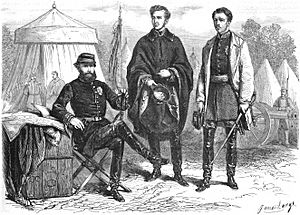
Gaston and Isabel were on their honeymoon in Europe when Paraguay attacked Brazilian provinces. Emperor Pedro II asked Gaston to return to Brazil and join the army.
Gaston, along with Emperor Pedro II and President Bartolomé Mitre of Argentina, helped in the Siege of Uruguaiana. This siege ended on September 18, 1865.
Gaston showed great interest in Brazil and its military. He was later made the general commander of the artillery. He also became president of the Commission of Improvements of the Army in November 1865.
Gaston wanted to fight in the war, but his requests were denied. The government believed that having a prince in the war might make the conflict worse. Also, the husband of the future empress could not be under the command of a Brazilian military officer.
On March 22, 1869, Gaston was finally chosen to lead the allied armies as commander-in-chief. He was only 27 years old, but he was known for his military skills.
The Brazilian public was happy with Gaston's appointment. Many people felt the war was going on for too long. When Gaston arrived in Paraguay, he reorganized the Brazilian army. He also fired officers who were stealing from enemy territory.
Gaston used clever tactics to trick the Paraguayan army. He showed great strategic ability and courage. He also played an active role in battles, even facing danger himself. It was Gaston's idea to end slavery in Paraguay, where many people were forced to fight.
Gaston became very sad due to the high number of deaths in the war. He returned to Brazil on April 29, 1870, as a war hero.
Family Life
Even though Gaston was not impressed with Isabel's looks at first, he grew to love her deeply. Their first son, Pedro, was born on October 15, 1875. This brought them much joy, especially after their first child, Luisa Victoria, died shortly after birth in 1874.
Pedro was a healthy child, though he had a small issue with his left arm from birth. Gaston was always patient and supportive of Isabel, helping her through any sadness she felt about Pedro's birth. Gaston was thrilled to be a father. He wrote to his own father, saying, "We are really happy, grateful and glad. Having two healthy children after so many misfortunes that made me lose any hope of becoming a father, exceeds what I dared myself to expect."
Their second son, Luiz, was born on January 26, 1878. He was named after Gaston's father. Luiz later became Isabel's heir when his older brother gave up his right to the throne. Their fourth and last son, Antonio, was born on August 9, 1881, in Paris.
Gaston was a very simple person. He tried to teach his children to be the same. He disliked the fancy lifestyle of European royalty, calling it "futile" and "stupid."
In 1882, Gaston chose Benjamin Franklin Ramiz Galvão, a respected professor, to educate his children. Gaston did not care that Benjamin was a republican, he only cared about his skills. Gaston and Isabel made sure their children had a simple education, sending them to regular schools.
Life as Prince-Consort
After marrying Isabel, Gaston wanted to be involved in the Brazilian government. He wanted to help the country develop. However, Emperor Pedro II never allowed Gaston or Isabel to be part of government decisions.
This caused some tension between Gaston and his father-in-law. Isabel often had to help them understand each other. Over time, Gaston accepted that he would not have political power. He and Isabel focused on helping others through charities and social groups.
One person who knew Gaston well said that he did everything he could to be a true Brazilian. He worked on plans for the army, schools, libraries, and orphanages. He truly cared for Brazil.
Gaston traveled to almost all parts of Brazil, more than any other member of the imperial family. He visited the south, northeast, and far north. People welcomed him warmly, showing that the monarchy was still popular. After the Paraguayan War, he received many honors from Brazil and other countries for his military service.
Later Years and Death

On November 15, 1889, a military coup took place in Brazil. The monarchy was overthrown, and a republic was declared. Gaston was one of the few people who wrote down what happened during the coup.
On the night of November 14, Gaston was preparing for a party. A major tried to warn him about something important, but Gaston was too busy. The next morning, November 15, he went for a ride with his sons, not knowing what was happening. When he returned, he read the newspapers. Only one mentioned a possible mutiny in the Military Academy.
Around 9:30 or 10:00 AM, Gaston learned that a rebellion had removed the government. He commented, "In this case, the monarchy has ended." He thought about putting on his Marshal uniform, hoping it would make the rebels change their minds, but decided it would not help.
Gaston, Isabel, and others met Emperor Pedro II. The Emperor seemed unaware of the seriousness of the situation. Gaston urged him to form a new government, but Pedro II did not act. Gaston tried to get the Emperor to meet with his advisors, but many left when the Emperor refused.
Later, a message came from the rebel leader, Deodoro da Fonseca. He said it was too late and the monarchy was over. He also wrongly blamed Gaston for problems between the government and the army. Gaston had no real power in the government, so this was unfair. The Imperial family was forced to leave Brazil on November 17.
Exile and Return
The Imperial family went into exile, first in Portugal, then in France. They settled at the Château d'Eu.
In 1891, Emperor Pedro II died. His daughter Isabel became "Empress Isabel I of Brazil" to those who still supported the monarchy. Gaston then became "Emperor Consort." However, these were just titles, as they were still banned from Brazil.
It was not until 1921 that Gaston could finally return to Brazil. He was a widower by then, as Isabel had passed away. The following year, on August 28, 1922, Gaston died at sea off the coast of Brazil. He was on a journey to celebrate Brazil's 100th year of independence. His body and Princess Isabel's body were brought back to Brazil in 1953. They were buried in the Imperial Mausoleum of the Cathedral of Petrópolis in 1971.
Honors and Awards
Prince Gaston received many important honors during his life.
He was given the Grand Cross of several Brazilian Orders, including:
- Order of Our Lord Jesus Christ
- Order of Saint Benedict of Aviz
- Order of Saint James of the Sword
- Order of the Southern Cross
- Order of Pedro I
- Order of the Rose
He also received many honors from other countries, such as:
- Grand Cross of the Order of Ernest the Pious (from Germany)
- Grand Cross of the Austro-Hungarian Order of Saint Stephen
- Grand Cross of the Portuguese Order of the Tower and Sword
- Grand Cross of the Portuguese Military Order of Our Lord Jesus Christ
- Grand Cross of the Portuguese Military Order of Saint Benedict of Aviz
- Knight of the Spanish Order of the Golden Fleece
- Grand Cross of the Royal and Distinguished Spanish Order of Carlos III
- Grand Cordon of the Belgian Order of Leopold
- Grand Cross of the French Légion d'honneur
- Grand Cross of the Imperial Order of the Mexican Eagle
- Grand Cross of the Military Order of Saint Fernando
- Knight of the Bavarian Order of Saint Hubert
Images for kids
See also
 In Spanish: Gastón de Orleans, conde de Eu para niños
In Spanish: Gastón de Orleans, conde de Eu para niños


